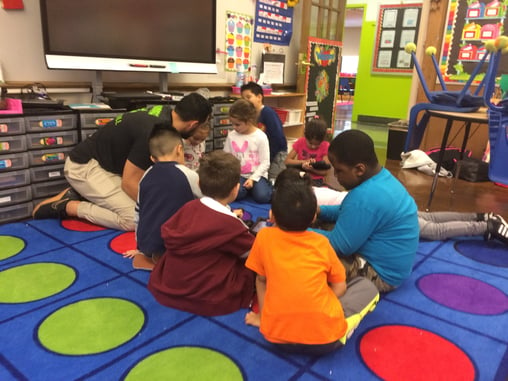
How do you set the tone for your classroom? How do you transition your students from one subject or activity to the next? How do you build a team spirit amongst your students? How do you differentiate yourself from everything else that your students experience throughout the course of their school day? Moreover, how do you do the same for your staff and your organization?
At The Leadership Program we talk a lot about the joy (and importance) of play. Many researchers are speaking out about the positive benefits of play, including Dr. Stuart Brown from the National Institute for Play. He makes compelling arguments about the transforming power of play, both for the workforce/educational institutions and for our health and well-being. But if you don’t have time to read his book or listen to his speeches, you can still discover this truth for yourself… by actually allowing yourself time to play—on your own and with your students.
Allowing yourself the space to play, or to be playful, may seem silly or even disingenuous. But if you actually give in to it, it won’t take long for you to notice changes in the way you feel—in mind, body, and in spirit. And one thing that we’ve discovered for sure—small activities can have huge impacts on our students. So we’re constantly looking for warm-up activities and games, ice breakers that help our students get to know each other, relax into our sessions, and learn a ton about themselves and their fellow students. Here are a few of our favorite activities to facilitate (with staff and students alike!).
Pass the “_____________”
- Give each table a small rubber duck, finger puppet, or bouncy ball
- Like “hot potato,” ask participants to start passing the object around the table when the music starts
- When the music stops, the person holding the object needs to answer a question with their table mates
- Sample questions include:
- What is your go-to middle of the night snack?
- What is one dream you have for the future?
- What is one of your silly fears?
- What do you love about working with youth?
- Do two or three rounds; on the last round tell the person holding the object that they can keep it
High Five!
- Ask participants to mill around the center of the circle without talking.
- Explain that when you call out a form of greeting, participants should find a person near them, say hello and then perform the greeting.
- Tell them that from then on, whenever they hear that form of greeting, they must find the same partner and perform that greeting. (It should be a different partner for each greeting.)
- Call out “Find a partner and shake hands with them. Remember who you shook hands with.” Every participant needs a partner. In the case of an odd number, a participant can partner with you.
- Have participants mill around again.
- Call out “Find a new partner and give them a high five. Remember who your high five partner is.”
- Tell participants “Now find that hand shake partner again and shake hands.”
- Begin calling out other greetings and ask participants to find people to partner with to:
- Bow
- Rub elbows
- Wink
- Bump Hips
- Touch toes
- Use all commands randomly. Ex: “Shake hands, touch elbows, wink, shake hands, high 5.”
- Speed up your greetings as participants get the hang of it to create a fun frenzy.
- Continue this for a few moments. To end the warm-up, give the command “high 5, high 5, high 5!”
Rock Paper Scissors Re-Mix
- Have participants break into pairs
- Remind everyone the rules of “Rock, Paper, Scissors”: Pairs shake their fists together, counting to three, and then after “three” they throw out either a rock, a scissors, or a paper. Rock crushes scissors, Scissors cuts paper, Paper covers rock
- Have each pair compete against each other, using the best 2 out of 3 shakes of Rock, Paper, Scissors
- In the first round, the person who loses is now the cheerleader for the winner in future rounds
- Have each pair find another pair to compete with—with the two winners competing and the two cheerleaders supporting their teammate.
- Each time someone wins they take their cheerleading squad to the next level … so after the foursome finishes, they find another foursome, and the two winners compete while the rest of the team cheer their team member on.
- Each team continues to compete until there are two opponents left
- Cheerleaders do a special introduction of their winner to the last opponent and the final two play to the finish
Leadership Snow Ball Fight
- Give each participant 3 pieces of paper
- Ask them to write one leadership quality that they possess on each sheet of paper.
- Then have them crumble up each paper with the leadership qualities, creating snowballs
- Split the room in half with two groups facing each other
- On the count of three, begin the snowball fight and allow participants to throw snowballs at each other for about a minute or two.
- Once you stop the game, have each person pick up three snowball from the ground and open them
- If the participants know each other:
- Have participants think about three other participants in the room that they believe have the same leadership qualities that are on the three snowballs.
- Ask participants to take the paper to those other participants and give it to them, sharing their leadership quality aloud.
- If the participants do not know each other:
- Have participants group with two or three others and discuss the leadership qualities they picked up—if they think they are important qualities, if they feel they possess those qualities, etc.
Crumple Ball
- Have the participants stand in a circle.
- Explain to them that we will be working on cooperation skills today, and the only way to “win” this game is if we work together as a team.
- Crumple a piece of paper into a ball, and explain to the class that the object of the game is for the group to keep the ball as many times as possible in a row by hitting it with your hand.
- Go over the game’s guidelines with the group:
- The group counts together out loud each time the ball is hit. If the ball is missed and hits the floor, the count starts over.
- You cannot hit the ball two times in a row. If someone does, the count starts over.
- If it is a larger group (more than ten participants), split them into two teams and have each team “compete” to see who can keep the ball in the air for the highest number, after giving them a few minutes to practice as a team.
Feel like you don’t have time for play? Yes, you do. At home or on the job, I assure you, you do. Feel like you’re too old to play? I assure you, you’re not. If the activities above don’t resonate with you, here are a few additional ideas for incorporating play into your program and your life, based on some of our favorite types of play from childhood. Hopefully this list will get your mind thinking of your own daily opportunities for play.
- Coloring! Fresh Crayons!What was better than that? So, start your next staff meeting or school program by having your team or students color with crayons and coloring pages. Or while your family is waiting for dinner, have crayons and coloring books on the table. Keep crayons in your purse for moments when you’re waiting– at the doctor’s office or the BMV line. This simple activity is grounding, and also provides an opportunity for quiet reflection.
- Beach Balls! Soccer Balls! Footballs! We loved to play catch, to toss a ball around. Have to get answers from your group about something? Instead of calling on a show of hands, toss a beach ball around the room to illicit responses. Want to determine how much your group understands a topic? Toss a soft ball around the room in a game of hot potato. Keep a ball at your desk and when you’re grappling with a question or an issue just toss it around for awhile.
- Puppets! Art! Creativity!Of course we were artists; that wasn’t even a question. Have your team make puppets out of brown paper bags to represent and introduce themselves. Challenge your students to create a group collage based on a common project or goal. Give your everyone purple pens and have them read Harold and the Purple Crayon.
- Building Blocks! Legos!Have your team build something with Legos while also discussing a topic of importance. Or just spend some time playing with Legos, whether by yourself, with a partner, or with kids.
- Dancing!30 second dance party. Enough said.
What, when you see it today, ignites the inner child in you? Balloons? Candy? Glitter? A perfect skateboarding ramp? A shiny wrapped present? A gigantic hot fudge sundae? A shelf filled with school supplies? A certain song? Think about how you can actively involve those things in your day.
It doesn’t take a lot of time to include these brief activities into your scheduled plan for the day, and the pay-off is undeniable. Don’t believe me? Give it a try. I triple dog dare you.
How can you play today?
"Warm-Ups, Games, Ice-Breakers, Oh My!", The Leadership Program, Inc. 2016




Comments [0]
Click here to read/write comments